| | |||
| Names | |||
|---|---|---|---|
| IUPAC name 1,3,5-Trioxane | |||
| Other names s-Trioxane; 1,3,5-Trioxacyclohexane; Trioxymethylene; Metaformaldehyde; Trioxin | |||
| Identifiers | |||
3D model (JSmol) | |||
| ChEBI | |||
| ChemSpider | |||
| ECHA InfoCard | 100.003.466 | ||
| RTECS number |
| ||
| UNII | |||
CompTox Dashboard (EPA) | |||
| |||
SMILES
| |||
| Properties | |||
| C3H6O3 | |||
| Molar mass | 90.078 g·mol−1 | ||
| Appearance | White crystalline solid | ||
| Density | 1.17 g/cm3 (65 °C)[1] | ||
| Melting point | 62 °C (144 °F; 335 K)[1] | ||
| Boiling point | 115 °C (239 °F; 388 K)[1] | ||
| 221 g/L[1] | |||
| Hazards | |||
| R-phrases (outdated) | R22 | ||
| S-phrases (outdated) | S24/25 | ||
| NFPA 704 (fire diamond) | |||
| Flash point | 45 °C (113 °F)[1] | ||
| Related compounds | |||
Related compounds | Formaldehyde | ||
Except where otherwise noted, data are given for materials in their standard state (at 25 °C [77 °F], 100 kPa). | |||
1,3,5-Trioxane, sometimes also called trioxane or trioxin, is a chemical compound with molecular formula C3H6O3. It is a white solid with a chloroform-like odor. It is a stable cyclic trimer of formaldehyde, and one of the three trioxane isomers; its molecular backbone consists of a six-membered ring with three carbon atoms alternating with three oxygen atoms.
Production
Trioxane can obtained by the acid-catalyzed cyclic trimerization of formaldehyde in concentrated aqueous solution.[2]
Uses
Trioxane is often used interchangeably with formaldehyde and with paraformaldehyde.[3][4] It is a precursor for the production of polyoxymethylene plastics, of which about one million tons per year are produced.[2] Other applications exploit its tendency to release formaldehyde. As such it is used as a binder in textiles, wood products, etc. Trioxane is combined with hexamine and compressed into solid bars to make hexamine fuel tablets, used by the military and outdoorsmen as a cooking fuel.
In the laboratory, trioxane is used as an anhydrous source of formaldehyde.[5]
See also
- Formaldehyde
- Paraformaldehyde
- Dioxane
- 1,3,5-Trioxanetrione
References
- ^ a b c d e Record in the GESTIS Substance Database of the Institute for Occupational Safety and Health
- ^ a b Reuss, Günther; Disteldorf, Walter; Gamer, Armin Otto; Hilt, Albrecht (2000). "Formaldehyde". Ullmann's Encyclopedia of Industrial Chemistry. Weinheim: Wiley-VCH. doi:10.1002/14356007.a11_619.
- ^ K. Chen; C. S. Brook; A. B. Smith, III (1998). "6,7-Dihydrocyclopenta-1,3-Dioxin-5(4H)-One". Organic Syntheses. 75: 189. doi:10.15227/orgsyn.075.0189.
- ^ D. S. Connor; G. W. Klein; G. N. Taylor; R. K. Boeckman, Jr; J. B. Medwid (1972). "Benzyl Chloromethyl Ether". Organic Syntheses. 52: 16. doi:10.15227/orgsyn.052.0016.
- ^ W. O. Teeters; M. A. Gradsten (1950). "Hexahydro-1,3,5-Tripropionyl-s-Triazine". Organic Syntheses. 30: 51. doi:10.15227/orgsyn.030.0051.



